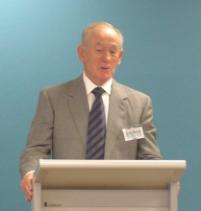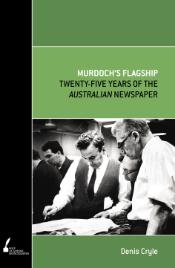Newspaper's role in national life 'worth chronicling'
Published on 11 December, 2008
The Australian newspaper's evolution, development and role in national life is a saga well worth chronicling, according to Australian Press Council Chairman Professor Ken McKinnon.
Professor McKinnon made his comments recently (Dec 4) while launching Professor Denis Cryle's new history, Murdoch's Flagship: Twenty-five Years of the Australian newspaper, 1964- 89.
History of 'The Australian' launched

Professor Ken McKinnon speaks at the launch
"I have great respect for role The Australian has played in Australian life," he said.
"It has undoubtedly facilitated the emergence of national attitudes and widened our horizons.
"It has been determinedly modern in introducing facsimile and other technology. The distribution system that makes it available first thing every day in diverse and far-flung locations is little short of amazing.
"Despite industrial relations, circulation, and distribution problems, not to mention other set-backs that would have crushed a less resilient and determined proprietor; it has continued to serve the nation. It is a great achievement."
Professor McKinnon said Professor Cryle had been able to write a detailed, well-authenticated account, giving us a clear picture of the experiences of so many people who were involved.
"His work has resulted in an excellent, indispensable study. I commend it to you," he said.
Professor McKinnon said The Australian's predilection for the proprietor's point of view was established early.
"Not much has changed. Unsourced gossip and innuendo from the current Canberra bureau, much of it manifestly and solely there to shape public attitudes, contrasts with the quality added to the paper by inclusion of more objective Wall Street Journal writing.
"The Australian's financial and special interest sections, on the other hand, contain the paper's most authoritative, balanced, and analytic writing.
"An interesting question is whether the evident desire to be influential in elections of individuals and parties, in Australian affairs, and even in business activity, have been the key negatives determining the limits on its circulation. Probably. The proprietors evidently see the trade-off as beneficial, but it is more likely that educated readers want balance.
"Respect for accuracy, or rather the lack of it, is another sore point. The Australian does no better than other Australian papers. Most go as far as an occasional small Corrections paragraph under the editorial credits on page two when there has been a flagrant inaccuracy. But in general, like other papers, The Australian has always been much freer with claims and charges than apologies or retractions. More positive attitudes to getting it right would improve papers and probably their circulations.
"Those points made, in many ways The Australian has been an indispensable accompaniment for my life and times.
"Many of the key journalists and editors I met in public life. Peter Hastings, its early foreign correspondent was a meticulous investigative reporter of Papua New Guinea matters when I was prominent in PNG life, Paul Kelly was reporting education matters when I first came back to Canberra as Chairman of an Education Commission, Maria Preraur was an influential and opinionated arts editor when I was undertaking a review of the future of Opera in Australia and Deputy Chairman of the Australia Council, and there were many others.
"Similarly, although I did not know the first two editors, Newton and Deamer, I have had interesting dealings with many of the later ones.
"Professor Cryle's new history .. says that its progress has been ‘uneven and uncharted'. It is this uneven path among other issues that makes it important to know how as the sole national broadsheet (the other national paper being the specialist Financial Review) got to its present eminence.
"Murdoch's personal involvement in founding and sustaining The Australian makes its history a study of special resonance. It is especially so as its founding was one of the earliest if not the first example of Murdoch's propensity to bet the company on bold and risky developments.
"Cryle vividly chronicles his detailed involvement in the very early stages. None of those early struggles completely explain why, despite later great overseas success, Murdoch maintained his deep interest in The Australian.
"As the only paper that he had started from scratch, Murdoch probably had an emotional attachment and considerable desire to prove his detractors wrong. From the beginning the company was on the edge with the loans required to keep it going and he tenaciously kept it going through 20 years of annual losses before turning the first profit of $10,000 in 1985.
"And, like the contemporaneous Fairfax and Packer dynasties, he knew newspaper ownership confers power and influence, which are there to be used. He certainly used his power to further his broader political and business ambitions.
"... Another partial explanation is that he has always been at heart a newspaper man, with ink in his veins.
"It probably hasn't ever been only about profit. Although he is notably hard-headed, he has often shown willingness to keep papers such as The Australian and the New York Post going long past the time when pure money men would have closed them."


